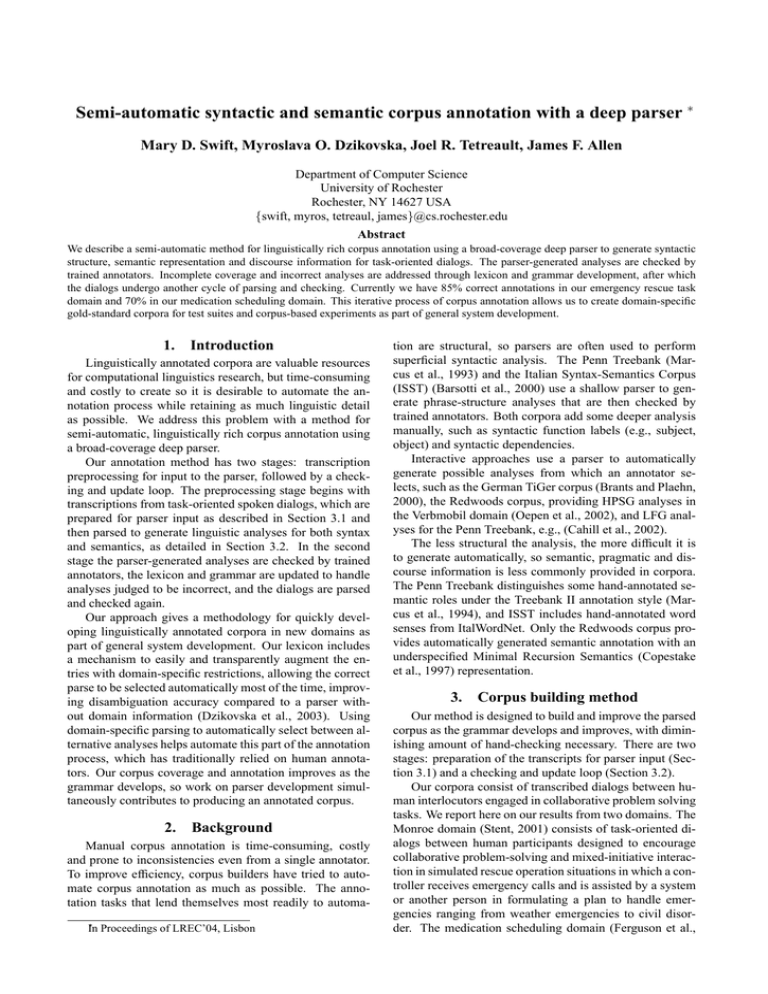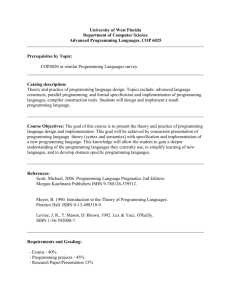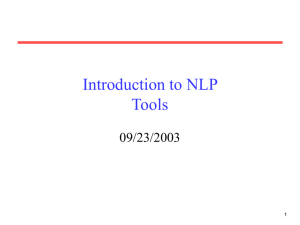Semi-automatic syntactic and semantic corpus annotation with a deep parser ∗
advertisement

Semi-automatic syntactic and semantic corpus annotation with a deep parser ∗
Mary D. Swift, Myroslava O. Dzikovska, Joel R. Tetreault, James F. Allen
Department of Computer Science
University of Rochester
Rochester, NY 14627 USA
{swift, myros, tetreaul, james}@cs.rochester.edu
Abstract
We describe a semi-automatic method for linguistically rich corpus annotation using a broad-coverage deep parser to generate syntactic
structure, semantic representation and discourse information for task-oriented dialogs. The parser-generated analyses are checked by
trained annotators. Incomplete coverage and incorrect analyses are addressed through lexicon and grammar development, after which
the dialogs undergo another cycle of parsing and checking. Currently we have 85% correct annotations in our emergency rescue task
domain and 70% in our medication scheduling domain. This iterative process of corpus annotation allows us to create domain-specific
gold-standard corpora for test suites and corpus-based experiments as part of general system development.
1. Introduction
Linguistically annotated corpora are valuable resources
for computational linguistics research, but time-consuming
and costly to create so it is desirable to automate the annotation process while retaining as much linguistic detail
as possible. We address this problem with a method for
semi-automatic, linguistically rich corpus annotation using
a broad-coverage deep parser.
Our annotation method has two stages: transcription
preprocessing for input to the parser, followed by a checking and update loop. The preprocessing stage begins with
transcriptions from task-oriented spoken dialogs, which are
prepared for parser input as described in Section 3.1 and
then parsed to generate linguistic analyses for both syntax
and semantics, as detailed in Section 3.2. In the second
stage the parser-generated analyses are checked by trained
annotators, the lexicon and grammar are updated to handle
analyses judged to be incorrect, and the dialogs are parsed
and checked again.
Our approach gives a methodology for quickly developing linguistically annotated corpora in new domains as
part of general system development. Our lexicon includes
a mechanism to easily and transparently augment the entries with domain-specific restrictions, allowing the correct
parse to be selected automatically most of the time, improving disambiguation accuracy compared to a parser without domain information (Dzikovska et al., 2003). Using
domain-specific parsing to automatically select between alternative analyses helps automate this part of the annotation
process, which has traditionally relied on human annotators. Our corpus coverage and annotation improves as the
grammar develops, so work on parser development simultaneously contributes to producing an annotated corpus.
2. Background
Manual corpus annotation is time-consuming, costly
and prone to inconsistencies even from a single annotator.
To improve efficiency, corpus builders have tried to automate corpus annotation as much as possible. The annotation tasks that lend themselves most readily to automa∗
In Proceedings of LREC’04, Lisbon
tion are structural, so parsers are often used to perform
superficial syntactic analysis. The Penn Treebank (Marcus et al., 1993) and the Italian Syntax-Semantics Corpus
(ISST) (Barsotti et al., 2000) use a shallow parser to generate phrase-structure analyses that are then checked by
trained annotators. Both corpora add some deeper analysis
manually, such as syntactic function labels (e.g., subject,
object) and syntactic dependencies.
Interactive approaches use a parser to automatically
generate possible analyses from which an annotator selects, such as the German TiGer corpus (Brants and Plaehn,
2000), the Redwoods corpus, providing HPSG analyses in
the Verbmobil domain (Oepen et al., 2002), and LFG analyses for the Penn Treebank, e.g., (Cahill et al., 2002).
The less structural the analysis, the more difficult it is
to generate automatically, so semantic, pragmatic and discourse information is less commonly provided in corpora.
The Penn Treebank distinguishes some hand-annotated semantic roles under the Treebank II annotation style (Marcus et al., 1994), and ISST includes hand-annotated word
senses from ItalWordNet. Only the Redwoods corpus provides automatically generated semantic annotation with an
underspecified Minimal Recursion Semantics (Copestake
et al., 1997) representation.
3.
Corpus building method
Our method is designed to build and improve the parsed
corpus as the grammar develops and improves, with diminishing amount of hand-checking necessary. There are two
stages: preparation of the transcripts for parser input (Section 3.1) and a checking and update loop (Section 3.2).
Our corpora consist of transcribed dialogs between human interlocutors engaged in collaborative problem solving
tasks. We report here on our results from two domains. The
Monroe domain (Stent, 2001) consists of task-oriented dialogs between human participants designed to encourage
collaborative problem-solving and mixed-initiative interaction in simulated rescue operation situations in which a controller receives emergency calls and is assisted by a system
or another person in formulating a plan to handle emergencies ranging from weather emergencies to civil disorder. The medication scheduling domain (Ferguson et al.,
2002) consists of dialogs in which a participant interacts
with another person playing the role of the system to work
out medication scheduling based on different patient needs
and situation parameters.
3.1. Transcription preparation
To prepare the transcribed speech for parser input we
have to do some utterance resegmentation followed by
manual annotation for disfluencies and ungrammatical or
incomplete utterances.
The segmentation in the original dialog transcripts separates utterances by user turn. Further segmentation is
needed on utterances that are conjunctions of several main
clauses that are coherent by themselves. Utterances are split
if there is an explicit coordinating conjunction between two
or more complete clauses, that is, each clause has subjectverb or subject-verb-object format and is joined by coordinating conjunctions and, but, or, etc. Only clauses with a
subject of you or we are exempt, so there can be implicit
subjects in preceding clauses. In the case of utterances
without explicit coordinating conjunctions, each utterance
must be able to stand by itself. Typically these are complete
sentences accompanied by short acknowledgment phrases
such as [Wait a minute] [I misunderstood] and [Right] [We
still have a road crew at the airport].
Handling speech repairs and incomplete utterances
presents additional difficulty to the problem of parsing human speech. We annotated our corpus with information
about disfluencies as follows. Words or phrases are marked
as disfluencies (indicated in square brackets) if the phrase is
repaired (e.g., [We’re gonna send the digging crew] we’re
gonna send the road crew from RGE to Elmwood bridge)
or repeated (e.g., [Can you] can you go over the thing for
me again?) immediately after in the same utterance. The
original utterance is retained in the corpus, but the input to
the parser does not include the disfluencies (as shown in the
Corpus Tool display in Figure 2).
We label utterances that are incomplete or ungrammatical but do not currently parse them. Incomplete utterances
meet one or more of the following criteria: 1) both subject
and verb are present, but at least one more constituent is
required to make sense, e.g., It and that is; 2) the utterance
consists of a single word that is not an acknowledgment
and does not qualify as an elliptical response to a previous
utterance; 3) the utterance ends with a half-finished word,
e.g., Actually it’s right a ab. Ungrammatical utterances do
not fit the above criteria for incomplete utterances but meet
one of the following criteria: 1) required constituents are
missing, such as articles or prepositions e.g., So ambulance
sends generator; 2) wording is incorrect, e.g., As terms of
crews I have two road crews; 3) there are morphological
errors, such as incorrect agreement marking.
The prepared utterances are placed in a format that includes fields such as the utterance to be parsed; the original utterance (complete with disfluencies); whether the
utterance is incomplete or ungrammatical; speaker label;
whether the utterance is part of a series of conjoined main
clauses; and fields that will be automatically filled in by
the parser for the syntactic and semantic analyses and the
timestamp of the parse.
3.2. Automatic generation of linguistic analyses
We use a broad-coverage deep parser based on a
bottom-up algorithm and an augmented context-free grammar with hierarchical features. The parser-generated syntactic representation consists of a derivation tree structure labeled with phrasal categories and terminal nodes, as
shown in Figure 1.1 The tree also includes word senses
and their base forms in the TYPE feature. The word senses
come from a domain-independent ontology developed together with the grammar. Our ontology for actions and
states (expressed by verbs and nominalizations) has a toplevel structure consistent with FrameNet (Johnson and Fillmore, 2000), though we use a smaller set of semantic
roles to make syntactic linking easier (Dzikovska, 2004).
The domain-independent ontology is combined with a domain model that adds selectional restrictions to the semantic role arguments, allowing the parser to choose the correct interpretation among available alternatives. Domainindependent semantic features are associated with each
word to differentiate between e.g., at the top level, physical objects, abstract objects, situations and times, each of
which has a set of basic semantic characteristics (see Figure
3 for examples of the :SEM feature vector).
The parser generates a semantic representation that is a
flat unscoped logical form with events and labeled semantic arguments. An abbreviated form is shown in Figure 2;
excerpts of the full terms from this form, which show the
semantic feature representation, are in Figure 3. Each term
includes an identifying variable (:VAR), indicating dependency relations between terms; the semantic class; semantic features (:SEM); the term type; and any modifications
(:MODS). Some information is specific to certain kinds of
terms, e.g., tense, modality and aspect (:TMA) is generated for terms obtained from verbs, and referential information (:CONTEXT-REL) for pronouns.The semantic representation also includes terms for null elements, such as
implied subjects in imperatives, and speech act information
in the form of a classification of the utterance as a statement, query, acknowledgment, rejection, etc.2
3.3. Checking and updating the corpus
The parser-generated analyses are automatically
checked in a post-processing stage as a rough guide for
annotators until the parses are checked by hand. The
analyses are hand-checked by trained annotators using a
software tool developed for this purpose, shown in Figure
2. Annotators use the tool to display the syntactic and
semantic analyses 3 for each utterance and assign a status
of GOOD or BAD. Comments on status assignments can be
entered, using keywords if applicable, e.g., BAD-SENSE if
an incorrect word sense appears in the analyses. Recording
the reasons for status assignment speeds up subsequent
cycles of annotation because known past problems can be
quickly checked. Initially, checking took between 2 and
4 hours (depending on the annotator) for a 300-utterance
1
Some leaf nodes are omitted due to space constraints.
Details of the parser’s semantic representation can be found
at http://www.cs.rochester.edu/research/cisd/resources/parser/lf.
3
Dependencies are highlighted with matching colors on the
:VAR to help the checking process.
2
Figure 1: Sample parse tree for s16 utterance 297
Figure 2: Top-level display of the logical form with the corpus tool
dialog. After a month of training, updated dialogs can be
checked at a speed of about 200 utterances per hour.
If multiple analyses are possible for a given utterance
due to lexical or syntactic ambiguity, and the top analysis
selected by the parser at run-time is not the correct one, alternate parses can be generated and the correct one selected
and saved in the gold-standard file. These analyses have the
status HAND-GEN, indicating that they are not the parser’s
first choice and had to be generated by iteratively parsing
the same utterance to obtain an alternate structure.
The hand-checked parses are used to identify problems
with the parser, which are addressed through lexicon and
grammar development, after which the dialogs are parsed
again. New parse results are automatically merged with the
old hand-checked parses. If the parse is unchanged, the new
parse is kept, with the old hand-checked status. Otherwise,
the new parses with their automatically assigned status replace the old ones, so they must be hand-checked. If the
parse changes and the old status is GOOD, the old entry
is retained for comparison. This iterative process is useful
for lexicon and grammar development, since the amount of
work spent on this phase diminishes as lexical and grammatical coverage increases.
4.
Results
For each of the dialogs, Table 1 shows the number of
parser-generated analyses that are good, hand-generated, or
bad, together with the number of utterances that are either
incomplete or ungrammatical (hence no parse attempted),
total utterances, and finally the percent of correct analyses
out of the utterances for which parses were generated.4
Our parser currently generates correct analyses for 85%
of the utterances in the Monroe corpus and 70% in the
MedAdvisor corpus. We continue to expand our coverage
to handle difficult phenomena common in spoken language,
such as elliptical responses e.g., So two stretcher and three
walking, uttered in reference to accident victims.
5.
Conclusions and future work
With this technique we will create annotated corpora for
multiple domains and use them to train a statistical parser.
We also plan to use the corpora to train the parser to automatically detect disfluencies and unparseable sentences
to save time in manual annotation. Additionally, since our
4
Medication domain analyses are from (Dzikovska, 2004).
(TERM :VAR V2105538
:LF (F V2105538 (:* LF::ARRIVE GET) :TO-LOC V2107296 :THEME V2104211 :MODS (V2107476))
:SEM ($ F::SITUATION (F::LOCATIVE F::ANY-LOCATIVE) (F::CAUSE -) (F::TIME-SPAN F::ATOMIC)
(F::ASPECT F::BOUNDED) (F::INTENTIONAL -) (F::INFORMATION F::PROPOSITION)
(F::CONTAINER -) (F::KR-TYPE KR::MOVE) (F::TRAJECTORY -) (F::TYPE F::EVENTUALITY)))
(TERM :VAR V2107296
:LF (THE V2107296 (:* LF::BUILDING HOSPITAL))
:SEM ($ F::PHYS-OBJ (F::OBJECT-FUNCTION F::PLACE) (F::ORIGIN F::ARTIFACT)
(F::FORM F::GEOGRAPHICAL-OBJECT) (F::MOBILITY F::FIXED) (F::GROUP -)
(F::SPATIAL-ABSTRACTION F::SPATIAL-POINT) (F::INTENTIONAL -) (F::INFORMATION -)
(F::CONTAINER -) (F::KR-TYPE KR::HOSPITAL) (F::TRAJECTORY -) (F::TYPE F::ANY-TYPE)))
Figure 3: Excerpt from full logical form for s16 utterance 297
Dialog
Good
Hand-Gen
Bad
Incomplete
Ungramm
Total Utts
% Correct
s2
325
9
34
35
2
405
90.8
s4
246
2
78
51
10
387
76.1
s12
151
0
17
19
2
189
89.9
s16
298
0
56
21
8
383
84.2
s17
311
1
54
23
3
392
85.3
Total
1331
12
239
149
25
1756
84.9
med1
47
0
12
1
0
60
79.7
med2
23
0
16
0
0
39
58.9
med3
30
0
18
0
0
48
62.5
med4
67
0
20
3
0
90
77
med5
32
0
19
4
2
57
61.5
Total
199
0
85
8
2
294
70.1
Table 1: Statistics for Monroe and MedAdvisor dialogs
corpora contain original utterances as well as their counterparts cleaned of disfluencies, it can be used for testing errorcorrecting parsers such as (Core and Schubert, 1999). The
rich semantics of the corpus will also facilitate reference
resolution studies and research on implicit roles, which requires a corpus with labeled thematic roles.
Our method builds linguistically annotated corpora
semi-automatically by generating syntactic, semantic and
discourse information with a broad-coverage, deep parser.
We use domain-specific semantic constraints to find the
correct analysis, eliminating the need to select the best
parse by hand from a set of alternatives. Incorrect analyses serve as input to lexical and grammatical development.
In this way, a linguistically annotated corpus is generated
as part of general system development, while our grammar
and lexicon improve in coverage and robustness.
6. References
Barsotti, F., R. Basili, M. Battista, O. Corazzari N. Calzolari, R. del Monte, F. Fanciulli, N. Mana, M. Massetani, S. Montemagni, M. Pazienza, F. Pianesi, R. Raffaelli, D. Saracino, A. Zampolli, and F. Zanzotto, 2000.
The Italian Syntactic-Semantic Treebank. In A. Abeille
(ed.), Building and using syntactically annoted corpora.
Kluwer.
Brants, T. and O. Plaehn, 2000. Interactive corpus annotation. In Proceedings of LREC2000.
Cahill, A., M. McCarthy, J. van Genabith, and A. Way,
2002. Automatic annotation of the Penn-Treebank
with LFG F-structure information. In Proceedings of
LREC2002 workshop on Linguistic Knowledge Acquisition and Representation.
Copestake, A., D. Flickinger, and I. A. Sag, 1997. Minimal
Recursion Semantics: An introduction. Technical report,
CSLI, Stanford University, CA.
Core, M. G. and L. K. Schubert, 1999. A model of speech
repairs and other disruptions. In S. E. Brennan, A. Giboin, and D. Traum (eds.), Working Papers of the AAAI
Fall Symposium on Psychological Models of Communication in Collaborative Systems. Menlo Park, CA.
Dzikovska, M. O., 2004. A Practical Semantic Representation for Natural Language Parsing. Ph.D. thesis, U.
Rochester.
Dzikovska, M. O., M. D. Swift, and J. F. Allen, 2003. Constructing custom semantic representations from a generic
lexicon. In Proceedings of IWCS5. Tilburg, Netherlands.
Ferguson, G., J. F. Allen, N. Blaylock, D. Byron, N. Chambers, M. Dzikovska, L. Galescu, X. Shen, R. Swier, and
M. Swift, 2002. The Medication Advisor Project. Technical Report 766, U. Rochester, Computer Science Department.
Johnson, C. and C. J. Fillmore, 2000. The FrameNet tagset
for frame-semantic and syntactic coding of predicateargument structure. In Proceedings ANLP-NAACL 2000.
Marcus, M. P., G. Kim, M. A. Marcinkiewicz, R. MacIntyre, A. Bies, M. Ferguson, K. Katz, and B. Schasberger,
1994. The Penn Treebank: Annotating predicate argument structure. In Proceedings of ARPA Human Language Technology Workshop.
Marcus, M. P., B Santorini, and M. A. Marcinkiewicz,
1993. Building a large annotated corpus of English: The
Penn Treebank. Computational Linguistics, 19:313–
330.
Oepen, S., D. Flickinger, K. Toutanova, and C. D. Manning,
2002. LinGO Redwoods: A rich and dynamic treebank
for HPSG. In Proceedings of First Workshop on Treebanks and Linguistic Theories (TLT2002).
Stent, A J., 2001. Dialogue Systems as Conversational
Partners. Ph.D. thesis, U. Rochester.




